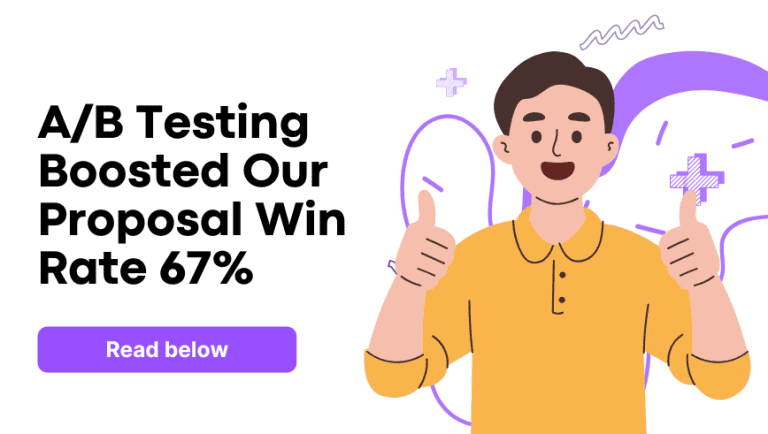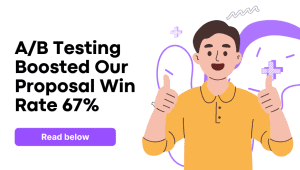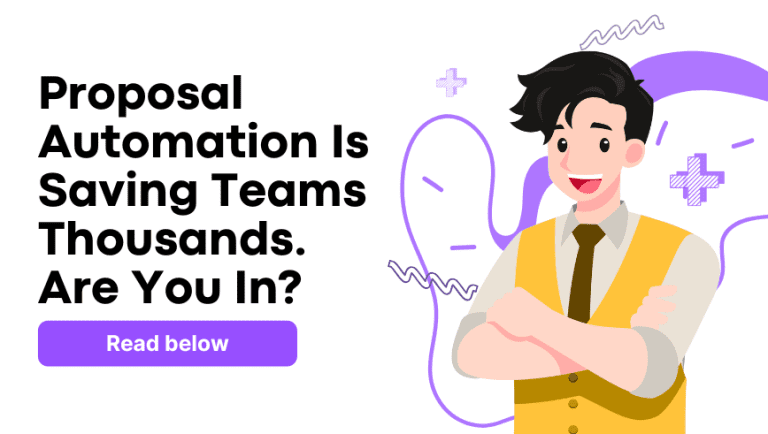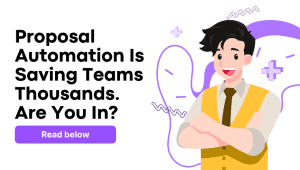We’ve reviewed thousands of proposals. Some won deals in days, others never even got opened again. The difference almost always comes down to one overlooked factor: how people actually read.
This isn’t about how they should read, or what we think they’ll read. It’s about the real patterns that determine whether a proposal gets read, understood, and responded to or forgotten entirely.
And according to research data, 81% of a reader’s total viewing time happens within the first three screenfuls of content. That’s roughly pages one through three. What happens before page four makes or breaks the proposal.
Let’s break this down through the lens of proposal reading psychology and show you what we’ve learned while building tools to help you win where it matters most.
Where Attention Lives and Dies
Most clients open a proposal while juggling five other tasks. They’re not seated with a cup of tea, ready to read every word. They’re skimming for signals.
Eye-tracking studies show users spend more than four-fifths of their attention on the first few screens. APMP, the leading proposal authority, backs this up by emphasizing that proposal evaluators often scan, not read. They’re hunting for clarity, confidence, and credibility fast.
Proposal reading psychology teaches us that once someone passes the third page or third scroll, cognitive attention drops. Retention dips. Curiosity flattens. And the likelihood of action shrinks.
If you’re not winning in that top section, you’re already behind.
What Proposal Reading Psychology Actually Involves
When we talk about proposal reading psychology, we’re referring to specific reader behaviors that shape every decision:

- Cognitive Load: Every line the reader has to interpret adds effort. Proposals should remove friction, not add to it.
- Primacy Effect: The first things a reader sees are the most influential. If your win themes aren’t upfront, they’re likely to be missed.
- Visual Processing: People respond to layout just as much as language. Format impacts trust.
- Pattern Recognition: Brains want order. Structured headings and recurring formatting patterns increase comprehension.
- Emotional Triggers: Confidence, trust, and familiarity all affect decision-making—before logic kicks in.
Here’s an example: a proposal we reviewed once placed all the pricing, testimonials, and benefits on page 9. Beautiful content, but it was never read. The reader responded to page 2, skimmed 3 and 4, and moved on.
The Executive Summary Is Your Opening Act
Proposal reading psychology emphasizes the weight of the executive summary. This section is often the only part everyone reads: decision-makers, technical evaluators, even finance teams.
And yet, it’s shocking how often this page is filled with fluffy intros or generic filler.
Strong executive summaries follow proposal writing best practices like:
- Clear value propositions
- Client-specific benefits
- Solution-impact alignment
If your proposal starts with “We are pleased to submit…” you’re burning your most valuable real estate. One of our users shortened their executive summary to just three core bullet points and saw a 40% increase in reply rates. Clarity compels action.
Skim Culture and Cognitive Load
Reading a proposal isn’t like reading a novel. It’s cognitive work.
Proposal reading psychology shows that people don’t follow a linear path. They dart between subheadings, highlights, numbers, and visual elements. Their brain is constantly asking: “What’s in it for me?”
The way we’ve approached this is by structuring proposals modularly. Each section carries a standalone value. No reader has to start from the beginning to understand the impact.
One user tested two versions of the same proposal: one with compact modules and bolded impact statements, the other with long narrative explanations. The modular version got twice as many callback replies.
Why Visual Representation Drives Decisions
Humans process visuals up to 60,000 times faster than text. That’s not just trivia, it’s central to proposal reading psychology.
A simple side-by-side chart explaining service tiers often works better than two paragraphs of explanation. Visual structure increases clarity, reduces fatigue, and builds trust.
Visual hierarchy also helps readers move from section to section smoothly. Bullet points, icons, and whitespace allow the eyes to reset. That moment of pause is where comprehension clicks.
A team we worked with once added a three-point impact bar with client logos on page 2. It became the most-cited element in follow-up meetings.
Why Proposals Get Ignored (Even Good Ones)
The number-one reason why proposals get ignored isn’t because the solution wasn’t strong. It’s because the presentation didn’t make that strength visible fast enough.
Here’s what we often see:
- Key benefits buried on page 7
- Excessive background before delivering the actual offer
- No clear call to action or next steps
- Design that feels more like a Word doc than a buying experience
Proposal reading psychology helps pinpoint these gaps before they cost you a deal.
How to Write Winning Proposals in 2025
Writing a winning proposal today is about more than saying the right thing. It’s about saying the right thing in the right place.

Here’s what high-converting proposals consistently do:
- Lead with win themes in your summary
- Use skimmable subheaders with client-centric phrasing
- Limit paragraphs to 3 lines
- Include visual reinforcements by page 2
- Clarify next steps before the reader reaches the end
These are not just proposal writing tips. They are habits born from data and attention studies across industries. They align directly with proposal reading psychology.
How AI Supports Reader Psychology Instead of Fighting It
AI-driven proposal tools can be helpful, but only when they understand how readers behave.
We’ve seen tools that generate paragraphs of content without any hierarchy. Readers scan past them. Others throw in templates without structure, assuming design will carry the message.
The real advantage of AI in proposal writing is when it mirrors human behavior. That means helping the writer match structure to scanning, tone to decision-stage, and layout to engagement.
AI should support the psychology, not override it.
Designing for the Reader’s Brain
We’ve studied how people actually read. Proposal reading psychology made one thing clear:
- They read less than you think
- They remember what’s visually framed
- They move faster than expected
- They decide earlier than you’d hope
That’s why everything from headings to page flow to font weight matters. A reader doesn’t remember your paragraph. They remember your structure.
Mobile and On-the-Go Reading Patterns
More than 40% of proposals are now opened on mobile devices. That’s not a UI statistic, it’s a psychology one.
Text-heavy, unstructured proposals feel overwhelming on mobile. Long sentences run longer. Headers fade into the body. Actions get missed.
Proposal reading psychology shows that compact, stacked content performs best in mobile settings. This is why visual hierarchy, line spacing, and modularity aren’t optional.
In one case, a two-column layout was swapped for a single-scroll design. Engagement time nearly doubled.
Social Proof and Behavioral Triggers
Readers don’t just look for what you offer. They look for signals that others found value in it.
Proposal reading psychology includes trust behavior. Testimonials, badges, and past results act as shortcuts for validation. The earlier they appear, the stronger their influence.
One agency added a brief quote from a past client just below their executive summary. That single line helped convert a hesitant prospect by answering a silent objection.
You don’t need a wall of proof, just one believable piece, placed early.
From Skim to Signature
When you learn how to write winning proposals, you realize something: most buying decisions aren’t made at the end. They’re made in the first few pages.
That’s why every piece of this process, from content to layout to psychology, needs to be intentional.
Proposal reading psychology tells us what works. It’s time to put that into action.
How Proposal.biz Goes Beyond Today’s Tools
We’ve seen how most proposal tools work. Some focus on formatting. Others help you plug in content blocks. A few even use AI to fill in text.
But very few are built with the actual reader in mind.
That’s where Proposal.biz takes a different route. We’ve studied how evaluators skim, where attention drops, and what actually pushes someone from reading to responding. Our system isn’t just designed to write proposals. It’s designed to build reading journeys.
It guides you to structure content based on behavioral pacing, not just length. It personalizes summaries in a way that reflects the client’s language, not just your credentials. It prompts you to place callouts, visuals, and CTAs where readers are most likely to notice them, often before they’ve even reached the halfway mark.
And unlike tools that prioritize automation over authenticity, we don’t remove your voice. We help your voice align with how people read.
Because a proposal is more than a document. It’s a decision-making experience. And every feature we build honors that.
Try What We’re Building
We’re building Proposal.biz for exactly this reason. A tool that doesn’t just generate content but helps shape how it’s received. It’s AI-powered, psychology-aligned, and outcome-driven.
And while it’s not live yet, we’re working to ensure it fits how people read, how teams decide, and how proposals should be made in 2025.
If this aligns with how you work, join our waitlist. Help us shape what modern proposal writing can be.
FAQs
What are the core elements of proposal reading psychology?
Cognitive load, visual design, decision behavior, and reader attention span. These determine how proposals are absorbed and acted on.
What are proposal writing best practices for 2025?
Start with the executive summary, structure content modularly, highlight benefits early, and use visuals to enhance clarity.
How to write winning proposals that clients actually engage with?
Focus on early impact, skimmable design, confident tone, and next-step clarity. Align message with the reader’s journey.
What are practical proposal writing tips for high engagement?
Use short paragraphs, bold win themes, add visuals, and keep CTAs visible throughout. Limit friction points.
Why proposals get ignored even when your solution is strong?
Value is often buried, not highlighted. Layout, timing, and readability impact visibility of your offer.




